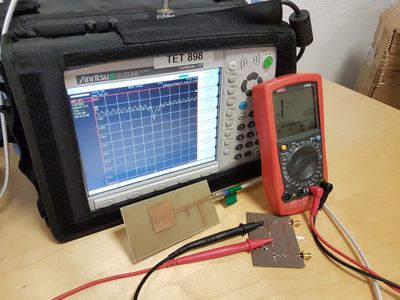- plane electromagnetic waves: reflection and transmission at oblique incidence at interfaces; critical angle; Brewster angle; polarization state
- transmission line theory: distributed parameters; characteristic impedance; matching; Smith chart; calculation of currents and voltages along a transmission line
- waveguides: mode decomposition in rectangular and circular hollow waveguides and in planar dielectric waveguides
- fields from general source distributions; Lorentz condition; time-dependent scalar and vector potentials
- basics of dipole antennas, straight wire antennas and antenna arrays; near-field and far-field properties; radiation pattern; radiation resistance; antenna measurements
- radiation fields from antenna arrays without coupling between the elements
- polarization, radiation pattern, beamwidth, directivity, antenna gain, efficiency and array factor of antennas
EI1222 Electromagnetic Theory, Continuation Course 6.0 credits

In this course, you will learn to understand the operation of basic microwave devices and antennas.
During the course, you will derive the electromagnetic response of transmission lines, waveguides and antennas. You will learn how to use commercial software of simulation, such as CST Microwave Studio. This software of simulation is extensively used in industry.
Your will learn how to perform basic measurements during our hands-on labs. You will visit the facilities of Ericsson and SAAB in Stockholm, understanding the everyday's work of a microwave engineer.
Finally, you will construct one matching network in microstrip technology. In the photo, you can see one example of a prototype built by former students in the course.
Information per course offering
Information for Spring 2026 CELTE programme students
- Course location
KTH Campus
- Duration
- 16 Mar 2026 - 1 Jun 2026
- Periods
Spring 2026: P4 (6 hp)
- Pace of study
33%
- Application code
60880
- Form of study
Normal Daytime
- Language of instruction
Swedish
- Course memo
- Course memo is not published
- Number of places
Places are not limited
- Target group
- No information inserted
- Planned modular schedule
- [object Object]
- Schedule
Contact
Course syllabus as PDF
Please note: all information from the Course syllabus is available on this page in an accessible format.
Course syllabus EI1222 (Spring 2024–)Content and learning outcomes
Course contents
Intended learning outcomes
After passing the course, the student should be able to
- use their conceptual understanding of the electromagnetic laws in order to qualitatively describe the behaviour of the solution to the problem
- use their ability to manage the electromagnetic laws to, in simpler situations, set up a computational model and perform the necessary calculations: select appropriate method; make proper approximations; assess the plausibility of the result
in order to be able to take advanced courses within the area.
Literature and preparations
Specific prerequisites
Knowledge in electromagnetic field theory, 10.5 higher education credits, equivalent completed course EI1220.
Active participation in a course offering where the final examination is not yet reported in LADOK is considered equivalent to completion of the course.
Being registered for a course counts as active participation.
The term 'final examination' encompasses both the regular examination and the first re-examination.
Literature
Examination and completion
Grading scale
Examination
- TEN1 - Written Exam, 6.0 credits, grading scale: A, B, C, D, E, FX, F
Based on recommendation from KTH’s coordinator for disabilities, the examiner will decide how to adapt an examination for students with documented disability.
The examiner may apply another examination format when re-examining individual students.
If the course is discontinued, students may request to be examined during the following two academic years.
Examiner
Ethical approach
- All members of a group are responsible for the group's work.
- In any assessment, every student shall honestly disclose any help received and sources used.
- In an oral assessment, every student shall be able to present and answer questions about the entire assignment and solution.
Further information
Course room in Canvas
Offered by
Main field of study
Education cycle
Supplementary information
In this course, the EECS code of honor applies, see: http://www.kth.se/en/eecs/utbildning/hederskodex.